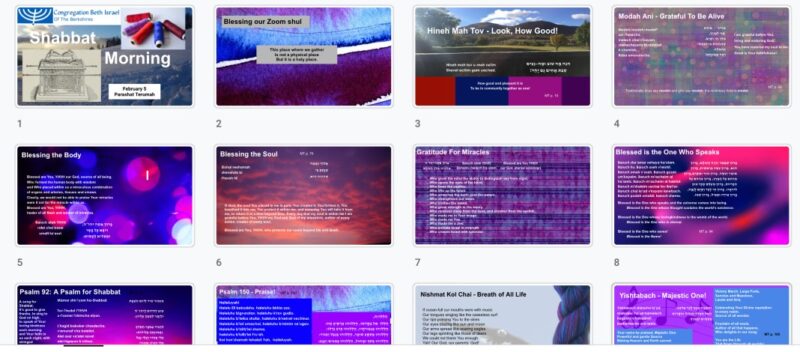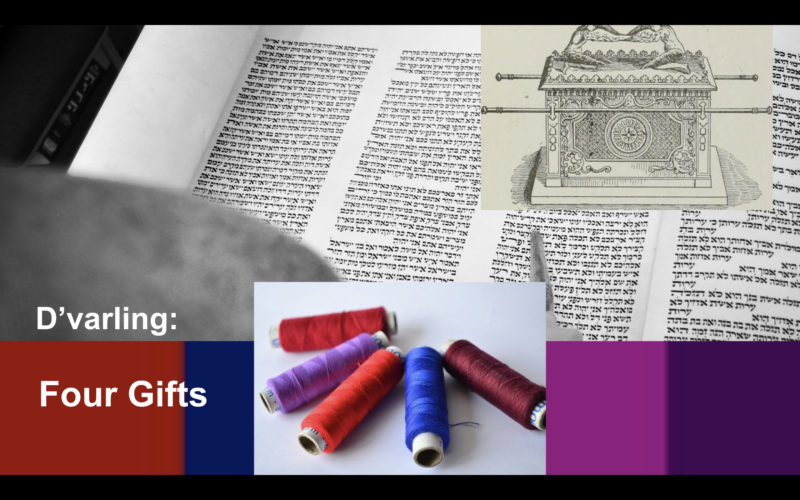This week’s Torah portion contains one of my favorite verses: “Let them make Me a sanctuary, that I might dwell among them.” The Hebrew could also mean “within them.” We build God a sanctuary so that God — holiness, love, justice — can dwell within us.
This year, I’m struck by the colors and the textures. Acacia wood covered over with hammered gold. Fine linen. Goat hair. Blue and purple and crimson, blue and purple and crimson, blue and purple and crimson. (Perhaps you’ve noticed those colors in this morning’s slides!)

A glimpse of our slides this morning.
I can almost feel the homespun cloth between my fingers, and the contrast with the fine linen. And my eyes crave the vibrancy. Picture the shining metals and acacia wood. The rich colors of blue and purple and crimson — in modern language, they “pop.”
I was talking with someone from the congregation this week who observed that it feels like we’ve collectively lost access to something we really need. We’ve lost spontaneity, or fun, or joy. Everything feels uphill, and joy feels out of reach. I hear that a lot, these days.
896,000 Americans have died from COVID so far. We lost 405,399 in World War II. We lost 58,000 in Vietnam. The number of COVID deaths thus far is so much higher, I can’t begin to process it. And that’s just here. Unlike any war, this virus is everywhere.
Dayenu, that would be enough! and then there’s school boards banning Holocaust books, and a caravan of angry people taking over downtown Ottawa, and — it’s a lot. It’s really and truly a lot. What tools can this Torah portion full of ancient blueprints give us for that?!
I found four. Here they are.
1. Beauty in the wilderness
At this moment in our story, our ancestors are arguably traumatized. They went from slavery and hard labor and constricted spirit, to wandering in the wilderness with no clear sense for what’s next. They’re probably exhausted, maybe afraid, and ready to be done.
Exhausted, maybe afraid, and ready to be done — does that ring a bell? And that’s exactly when God says: bring the gifts of your heart, everyone who is so moved. Bring wood and precious metals, bring the most vividly-colored yarn and fabric, and make beauty.
Our hearts and souls and spirits need beauty, even in the wilderness — or maybe especially in the wilderness. It may be tempting to say that art and beauty, vibrant colors and music, sacred spaces of all kinds are a luxury. Torah teaches otherwise.
2. Sanctuary
Think about the meaning of the English word sanctuary. As in, “give me sanctuary!” To me it evokes a safe place, a sacred space, a place where no one can hurt me. A place where I can flee from all of life’s troubles. Where I’m safe, and can feel hopeful, and be at peace.
Wow, I yearn for that right now. I’ll bet some of you do too. A place of safety and holiness and dignity, a place where nothing and no one will do us harm, a place where we can lay down our load and be at peace and maybe even feel joy. Like a vacation, but deeper and more real.
We need that, just as our ancient ancestors did. And the only way to build it is together. To build a mishkan (from the root שכנ, as in Shechinah, divine Presence) — to build a place where God can dwell — requires all of us… and that safe holy place is for everyone.
3. Use what we’ve got
Like our spiritual ancestors, we can use what we have to connect with holiness wherever we are. They had acacia and gold, blue and purple and crimson yarn. Maybe right now, for us, it’s a special tablecloth, or a hand-knitted sweater, or a cherished recipe: all tools for holiness.
Shabbat can be a sanctuary — a day set-apart from the turmoil of the week. Music can be a sanctuary. For me, lately, that’s meant singing along with the Encanto soundtrack! When I’m singing, I am lifted out of where I’ve been. A contemplative cup of tea can be a sanctuary.
Right now, between pandemic and February ice storms, we may feel stuck. But wherever we are can be a holy place, because God goes with us in all of our wanderings. That’s why the Ark of the Covenant had gold rings in the side, and gold-covered poles always in the rings.
4. Bringing our gifts
And when COVID numbers go down and we gather onsite again, we will bring our gifts to community. That’s what the name of this week’s Torah portion means: t’rumah, the freewill gifts of the heart. The mishkan was built because everyone was moved to help build it.
What kind of holy community do we want to build together when the snows melt, when the voice of the red-winged blackbird is heard again in the willow tree behind our shul? And what can each of us bring? Because building community is like Stone Soup. It needs all of us.
The mishkan isn’t a building, as beautiful as our building is. The mishkan is community — the way we uplift and take care of each other, learn with each other, pray with each other, do mitzvot with each other. That’s how we make a mishkan where holiness really dwells.
This is Rabbi Rachel’s d’varling from Shabbat morning services. Cross-posted to Velveteen Rabbi.






